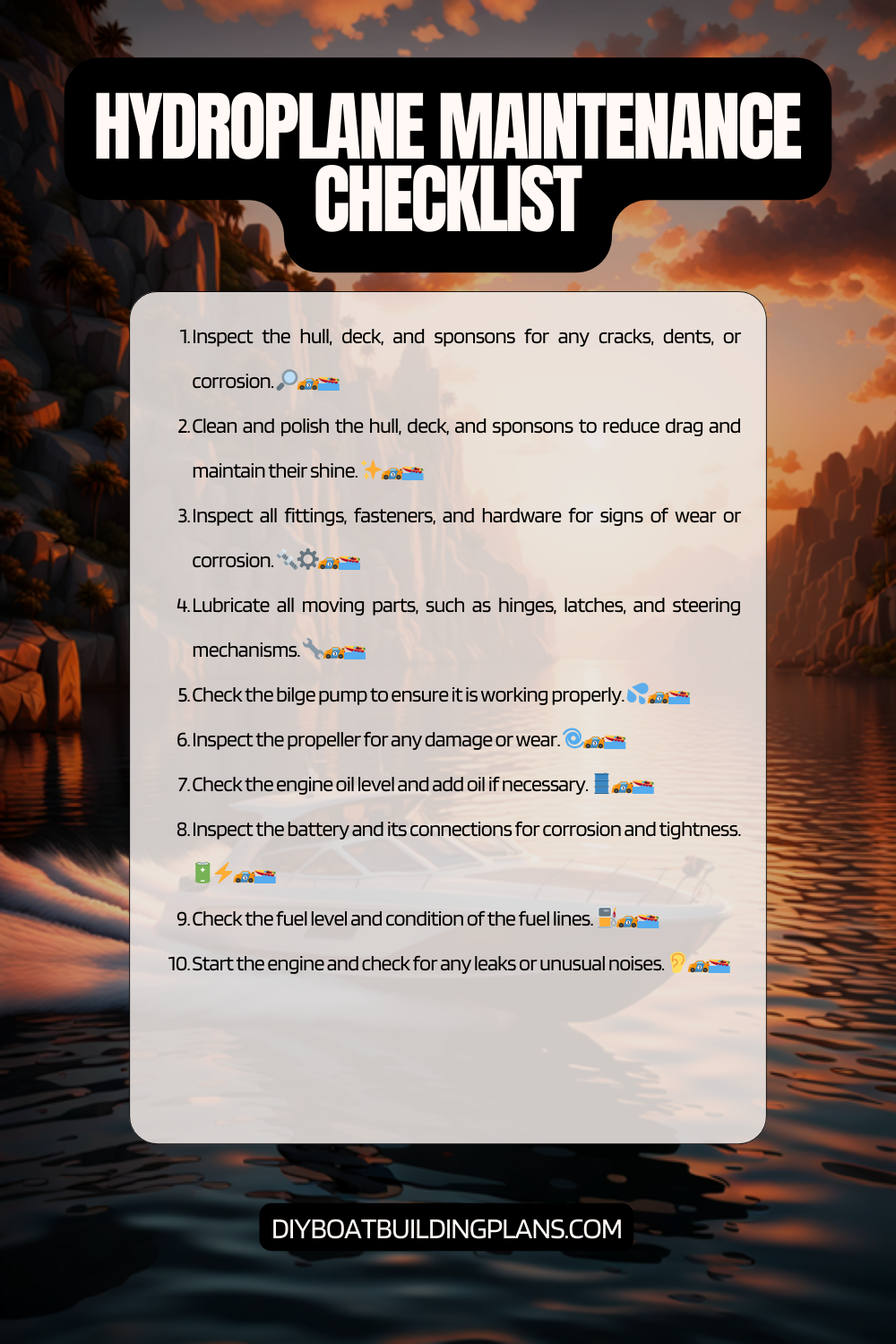Overview of Hydroplane Maintenance Tips
Hydroplanes are high-speed boats that are designed to skim across the water’s surface, providing an exhilarating experience for both the driver and passengers. These boats are known for their sleek design and powerful engines, which allow them to reach impressive speeds. However, with this speed and power comes the need for regular maintenance to ensure optimal performance and safety.
Unlike traditional boats, hydroplanes have unique maintenance needs due to their high-performance nature. The engines in hydroplanes are often more powerful and require more frequent attention to keep them running smoothly. Additionally, the hulls of hydroplanes are designed to minimize drag and maximize speed, which means they need regular inspection and repair to prevent any issues that could compromise performance.
Key Takeaways
- Regular maintenance is crucial for the optimal performance and longevity of hydroplanes.
- A basic maintenance checklist includes checking and changing oil, inspecting propellers, hulls, decks, and electrical systems.
- Keeping the engine clean and running smoothly is essential for the hydroplane’s performance.
- Winterizing your hydroplane before off-season storage is important to prevent damage and ensure a smooth start-up next season.
- Avoid common maintenance mistakes such as neglecting regular maintenance, using incorrect oil, and not properly storing the hydroplane.

Importance of Regular Maintenance for Hydroplanes
Regular maintenance is crucial for hydroplanes to ensure both safety and optimal performance. Neglecting maintenance can have serious consequences, not only for the boat but also for those on board. By regularly inspecting and maintaining your hydroplane, you can identify and address any potential issues before they become major problems.
One of the most important reasons for regular maintenance is safety. Hydroplanes operate at high speeds, and any mechanical failure or malfunction can lead to accidents or injuries. By regularly checking and maintaining your hydroplane, you can minimize the risk of these incidents occurring.
In addition to safety concerns, regular maintenance also plays a significant role in the performance of your hydroplane. A well-maintained boat will operate more efficiently, allowing you to achieve higher speeds and better handling. Neglecting maintenance can result in decreased performance, increased fuel consumption, and even engine damage.
Basic Hydroplane Maintenance Checklist
To ensure the proper maintenance of your hydroplane, it is essential to follow a basic maintenance checklist regularly. This checklist should include tasks that cover various aspects of your boat’s operation.
Firstly, checking fluid levels is crucial. This includes engine oil, coolant, and hydraulic fluid. Low fluid levels can lead to engine overheating or damage, so it is important to keep them at the recommended levels.
Inspecting belts and hoses is another important task. Over time, belts can become worn or loose, leading to decreased performance or even engine failure. Hoses should also be checked for any signs of wear or leaks.
Cleaning the hull is also a vital part of hydroplane maintenance. The hull is constantly exposed to water, which can lead to the growth of algae and other organisms. Regular cleaning will prevent the buildup of these substances, which can negatively impact performance.
Tips for Checking and Changing Hydroplane Oil
| Tips for Checking and Changing Hydroplane Oil |
| 1. Check oil level regularly to ensure proper lubrication. |
| 2. Use the recommended oil type and viscosity for your hydroplane. |
| 3. Change oil at recommended intervals or as per manufacturer’s instructions. |
| 4. Use a clean oil filter during oil change to prevent contaminants from entering the system. |
| 5. Dispose of used oil and filter properly to avoid environmental damage. |
| 6. Inspect oil for signs of contamination or discoloration and take appropriate action. |
| 7. Keep oil reservoir and surrounding area clean to prevent debris from entering the system. |
Checking and changing the oil in your hydroplane is a critical maintenance task that should not be overlooked. Oil plays a crucial role in lubricating the engine’s moving parts and preventing excessive wear and tear.
To check the oil level, start by ensuring that your hydroplane is on a level surface. Locate the dipstick, usually near the engine, and remove it. Wipe it clean with a cloth or paper towel, reinsert it fully, and then remove it again to check the oil level. The dipstick will have markings indicating the minimum and maximum levels. If the oil level is below the minimum mark, it’s time for an oil change.
When changing the oil, make sure to follow the manufacturer’s recommendations for the type and viscosity of oil to use. Drain the old oil by removing the drain plug or valve located on the bottom of the engine’s oil pan. Allow all the old oil to drain completely before replacing the drain plug.
After draining the old oil, remove and replace the oil filter. Apply a thin layer of new oil to the rubber gasket on the new filter before installing it. Once the new filter is in place, refill the engine with fresh oil using a funnel to avoid spills. Check the oil level again using the dipstick and add more oil if necessary.
How to Keep Hydroplane Engines Clean and Running Smoothly
Keeping your hydroplane’s engines clean and well-maintained is essential for optimal performance and longevity. Over time, engines can accumulate dirt, debris, and even saltwater residue, which can hinder their performance and lead to mechanical issues.
Regularly inspecting and cleaning the engine’s air filters is a crucial maintenance task. Air filters prevent dirt and debris from entering the engine, ensuring clean air for combustion. Clogged or dirty air filters can restrict airflow, leading to decreased performance and increased fuel consumption. Clean or replace the air filters as recommended by the manufacturer.
Another important aspect of engine maintenance is checking and replacing spark plugs. Spark plugs ignite the fuel-air mixture in the engine’s cylinders, providing the necessary combustion for power. Over time, spark plugs can become fouled or worn, leading to misfires or poor engine performance. Inspect the spark plugs regularly and replace them if necessary.
Additionally, it is important to keep the engine compartment clean and free from debris. Use a soft brush or cloth to remove any dirt or grime that may have accumulated on the engine surfaces. Avoid using high-pressure water or harsh chemicals that could damage sensitive components.
Maintaining Hydroplane Propellers for Optimal Performance
The propeller is a vital component of a hydroplane that directly affects its performance and safety. Proper maintenance of propellers is essential to ensure optimal performance and prevent any issues that could compromise safety.
Regularly inspecting propellers for damage or wear is crucial. Look for any signs of dents, cracks, or bent blades. Even minor damage can significantly impact performance and cause vibrations that can damage other components of your hydroplane. If any damage is detected, it is important to repair or replace the propeller promptly.
Cleaning propellers is also an important maintenance task. Over time, propellers can accumulate marine growth, such as algae or barnacles, which can negatively affect performance. Use a soft brush or scraper to remove any buildup from the propeller blades. Avoid using harsh chemicals that could damage the propeller’s surface.
Properly balancing the propeller is another aspect of maintenance that should not be overlooked. An unbalanced propeller can cause vibrations and lead to premature wear on other components. If you notice excessive vibrations or unusual noises while operating your hydroplane, it may be a sign that the propeller needs to be balanced.
Inspecting and Repairing Hydroplane Hulls and Decks
The hull and deck of a hydroplane are critical components that require regular inspection and repair to ensure safety and optimal performance. The hull is responsible for providing buoyancy and stability, while the deck protects the interior components from water damage.
Regularly inspecting the hull for cracks, dents, or other signs of damage is essential. Even small cracks can compromise the structural integrity of the hull and lead to water leaks or even sinking. If any damage is detected, it is important to repair it promptly using appropriate materials and techniques.
Inspecting the deck for any signs of wear or damage is also crucial. Pay close attention to areas where fittings or accessories are attached, as these can create stress points that may lead to cracks or leaks over time. Repair any damage using suitable materials and techniques recommended by the manufacturer.
Regularly cleaning and waxing the hull and deck is another important maintenance task. This not only keeps your hydroplane looking its best but also helps protect the surfaces from UV damage and corrosion. Use a mild detergent and a soft brush or cloth to clean the surfaces, and apply a high-quality marine wax to provide added protection.
Tips for Maintaining Hydroplane Electrical Systems
Maintaining the electrical systems of your hydroplane is crucial for both safety and performance. Electrical issues can lead to malfunctions or failures of critical components, such as navigation lights, bilge pumps, or ignition systems.
Regularly inspecting the electrical wiring for any signs of wear, corrosion, or loose connections is essential. Pay close attention to areas where wires are exposed or come into contact with other components. Repair or replace any damaged wiring promptly to prevent further issues.
Checking the battery regularly is also important. Ensure that the battery terminals are clean and free from corrosion. If necessary, clean the terminals using a wire brush and apply a thin layer of petroleum jelly to prevent future corrosion. Additionally, check the battery’s charge level and recharge or replace it as needed.
Inspecting and testing electrical components, such as switches and fuses, is another important maintenance task. Make sure that all switches are functioning properly and that fuses are not blown. Replace any faulty components to ensure proper operation of your hydroplane’s electrical systems.
Winterizing Your Hydroplane: Preparing for Off-Season Storage
Winterizing your hydroplane is essential if you live in an area with cold temperatures or if you plan to store your boat for an extended period. Proper winterization helps protect your hydroplane from freezing temperatures and prevents damage that can occur during storage.
One of the first steps in winterizing your hydroplane is draining all fluids, including engine oil, coolant, and fuel. This prevents any residual fluids from freezing and causing damage to the engine or fuel system. Consult your hydroplane’s owner’s manual for specific instructions on how to drain these fluids properly.
Protecting the hull during winter storage is also crucial. Thoroughly clean the hull and deck, removing any dirt or debris that could cause damage over time. Apply a high-quality marine wax to provide added protection against UV rays and corrosion.
Covering your hydroplane with a suitable boat cover is another important step in winterization. A cover will protect your boat from the elements and prevent any unwanted debris or critters from entering. Make sure the cover is secure and properly fitted to provide maximum protection.
Download over 500 Boat Plans. Click on the link below.
-->Click Here<--
Common Hydroplane Maintenance Mistakes to Avoid
While regular maintenance is crucial for hydroplanes, there are common mistakes that owners often make that can compromise the effectiveness of their efforts. By avoiding these mistakes, you can ensure that your hydroplane receives the proper care it needs.
One common mistake is neglecting regular maintenance tasks. It is important to follow a maintenance schedule and perform tasks as recommended by the manufacturer. Skipping or delaying maintenance can lead to serious issues down the line.
Another mistake is using incorrect or low-quality materials during maintenance. Always use materials and products that are recommended by the manufacturer to ensure compatibility and effectiveness. Using subpar materials can lead to premature wear or damage to your hydroplane.
Lastly, overlooking small issues or signs of damage is a mistake that can have serious consequences. It is important to address any problems promptly, even if they seem minor. Small cracks, leaks, or unusual noises can be indicators of larger issues that need attention.
Hydroplane Maintenance Checklist

Conclusion – Hydroplane Maintenance Tips
In conclusion, regular maintenance is essential for hydroplanes to ensure safety and optimal performance. By following a comprehensive maintenance checklist and avoiding common mistakes, you can keep your hydroplane in top condition.
From checking fluid levels and changing oil to inspecting propellers and maintaining electrical systems, each aspect of hydroplane maintenance plays a crucial role in keeping your boat running smoothly. Regular inspections, cleaning, and repairs are necessary to prevent issues from escalating and compromising safety.
By following the provided tips and guidelines for hydroplane maintenance, you can enjoy the thrill of high-speed boating while ensuring the longevity and reliability of your hydroplane. Remember, proper maintenance is not only about performance but also about safety for both you and your passengers.
FAQs – Hydroplane Maintenance Tips
What is a hydroplane?
A hydroplane is a type of boat that is designed to skim across the surface of the water using hydrodynamic lift.
Why is maintenance important for hydroplanes?
Maintenance is important for hydroplanes to ensure that they are safe to operate and to extend their lifespan. Regular maintenance can also help prevent costly repairs.
What are some basic hydroplane maintenance tips?
Some basic hydroplane maintenance tips include checking the engine oil and other fluids regularly, inspecting the propeller for damage, cleaning the hull and deck, and storing the boat properly when not in use.
How often should I change the oil in my hydroplane?
The frequency of oil changes in a hydroplane depends on the manufacturer’s recommendations and the type of oil used. Generally, it is recommended to change the oil every 50-100 hours of operation or at least once a year.
What should I do if I notice damage to my hydroplane?
If you notice damage to your hydroplane, it is important to address it as soon as possible to prevent further damage or safety issues. Depending on the severity of the damage, you may need to take the boat to a professional for repairs.
How can I prevent corrosion on my hydroplane?
To prevent corrosion on your hydroplane, it is important to rinse the boat with fresh water after each use, especially if it has been in saltwater. You can also apply a protective coating to the metal parts of the boat to help prevent corrosion.



